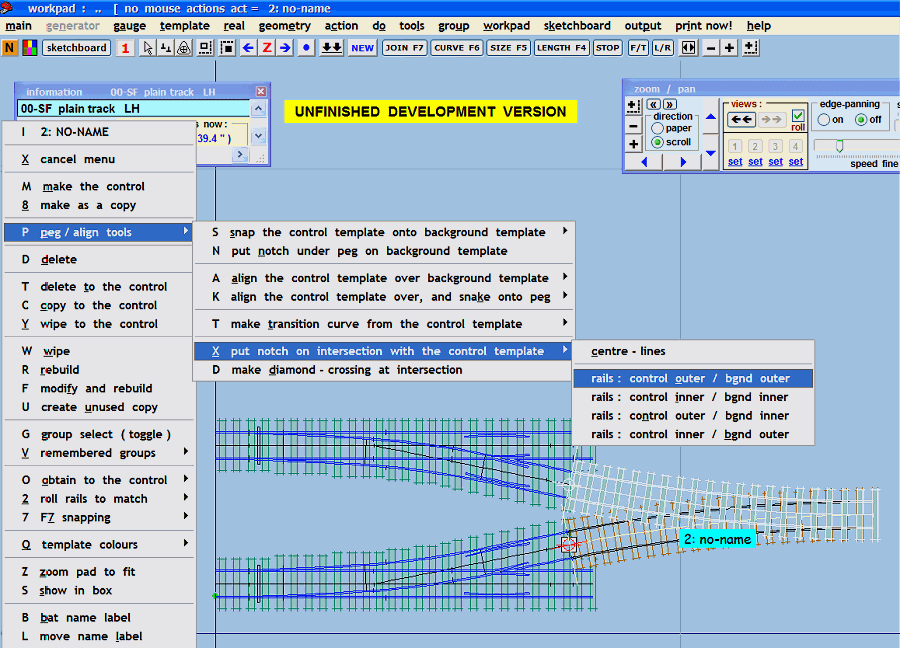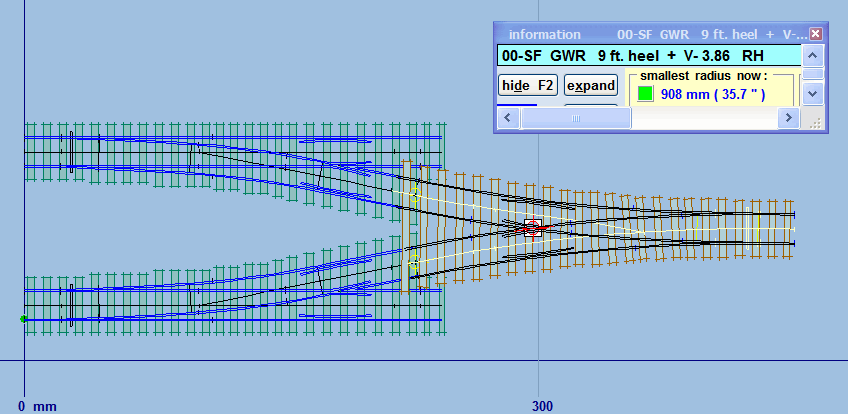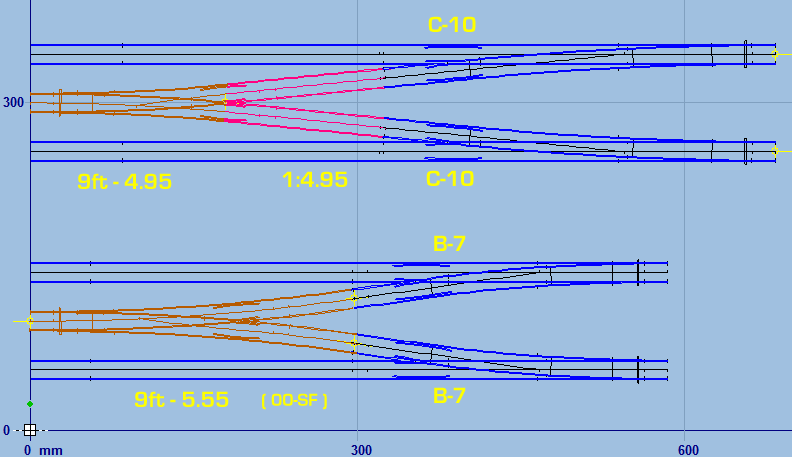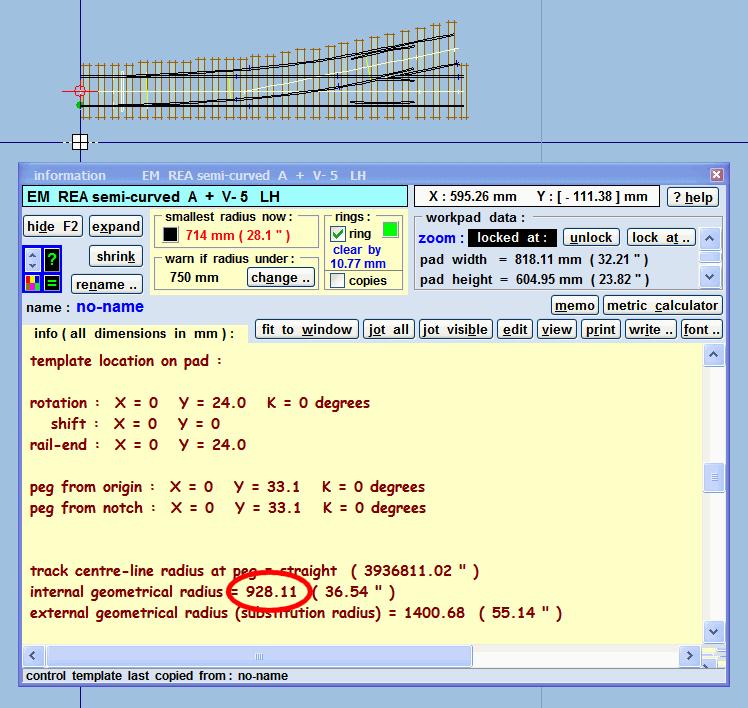Templot Club Archive 2007-2020
|
|||
| author | remove search highlighting | ||
|---|---|---|---|
|
posted: 5 Aug 2011 18:43 from: Hayfield
click the date to link to this post click member name to view archived images |
I need to build a Y turnout in EM to match an A5 turnout, they do not connect directly to each other but I need the Y turnout to be a bit smaller in size than the A5. As the crossing angle is increased by turning the standard turnout into a Y, what is the safeist smaller crossing angle I can use please Is it best to start with an A5 and reduce the size or stary with a smaller crossing angle Thanks in advance John |
||
|
posted: 5 Aug 2011 19:42 from: Martin Wynne
click the date to link to this post click member name to view archived images |
Hi John, Sorry, I'm not too sure I understand the question. If it's the same question as the recent discussion on RMweb, the answer for 00-SF at the scale track spacing (44.67mm) is 1:3.86 crossing angle curviform. I used a GWR curved 9ft switch to get the best fit. The radius is just under 36". The TDV makes it very easy to do this -- here are some screenshots to explain. I started with tools > make return curve for each A-5 turnout. I'm sorry I have to go out now so I don't have time to write in detail. I will write again tomorrow. 2_051431_550000000.png  2_051431_550000001.png  2_051431_560000002.png  regards, Martin. |
||
|
posted: 5 Aug 2011 20:21 from: Hayfield
click the date to link to this post click member name to view archived images |
Martin Thanks I will try that as it might answer my question, sorry I did not explain my self clearly. Here is another go If I convert an A5 turnout to a Y turnout does the crossing angle of the Y become 1 in 10 for each road. If so could I use an A4 or A3.5 crossing so that the crossing angle of the Y turnout decreases to a 1 in 8 or 1 in 7 so that the difference between it and a standard A5 turnout is not so great. |
||
|
posted: 5 Aug 2011 20:49 from: Glen Suckling
click the date to link to this post click member name to view archived images |
Hayfield wrote: If I convert an A5 turnout to a Y turnout does the crossing angle of the Y become 1 in 10 for each road..Just a quick rule of thumb: The frog angle of a Y turnout is half of the frog angle of a matching right or left hand turnout. I.E. using the second picture in Martin's reply - if the Y is a No. 5 the matching straight turnouts will have to be No. 10s. I hope that this helps, Glen |
||
|
posted: 5 Aug 2011 20:57 from: Nigel Brown click the date to link to this post click member name to view archived images |
John If I understand your question, an A5 turnout is an A5 turnout, no matter what the shape of the turnout. What I think you're getting at, is that if you have a Y A5 turnout, is the (minimum) radius you end up with in either road of the turnout significantly more than the radius of the curved road of a straight A5 turnout. The answer is yes, so if you want a fairly compact Y turnout, and you reckon that the curve in straight A5 turnout gives the sort of minimum radius you're looking for, it's possible to decrease crossing angle of the Y turnout until the radius is in that sort of region. What I suggest you do is note the minimum radius quoted for a straight A5 turnout, convert it to a Y turnout, then decrease the crossing angle until the radius is in the same region, making any adjustments necessary to the curvature of the (main road of) the Y turnout at the same time. That'll give you an idea of the crossing angle required. Alternatively, just make a guess, like A3.5, and see what that gives you. However, I think sharply curved Y turnouts look a bit peculiar; you might want to make the crossing angle a bit larger to improve appearances. Nigel |
||
| Last edited on 5 Aug 2011 20:58 by Nigel Brown |
|||
|
posted: 5 Aug 2011 23:52 from: Martin Wynne
click the date to link to this post click member name to view archived images |
Glen Suckling wrote:Just a quick rule of thumb:Hi Glen, Yes as a quick rule of thumb, but it depends how precise you want to be. To make a strictly correct regular crossover, the straight turnouts need to be 1:10 RAM, and the Y-turnout needs to be 1:5 CLM. 1:5 CLM is equivalent to 1:4.95 RAM. (do > convert RAM to CLM menu item). So to be consistent the crossover is 1:10 + 1:4.95 in RAM units. This is shown in the upper part of the diagram. The Y-turnout has a 9ft switch and a 1:4.95 V-crossing. The linking roads are straight, so in order to complete the design in Templot you need to do some additional work to terminate the turnout curves at the V-crossing. You could use partial templates as shown split at the fine point (CTRL-4). The pink template is a 1:4.95 straight half-diamond, again split at the fine point. Or you could instead do it all in one template by putting a zero-length transition-to-straight at the fine point. Either way however, using a regular crossover like this is not the best design and is very wasteful of space: 2_031930_100000000.png  You can save about 100mm (4") in 4mm scale and have an easier radius in the Y-turnout by making a curviform crossover instead, as shown in the lower part of the diagram. In this case the straight turnouts are B-7. I did tools > make return curve to create two overlapping curves. I then created a curviform Y-turnout and aligned it over the curves at the fine point intersection. The result was a Y-turnout with a 9ft switch and 1:5.55 crossing -- i.e. a longer Y with an easier radius, even though the overall crossover is much shorter. The Templot Development Version (TDV) contains some new functions which make it easier to find such intersections and determine the crossing angle. regards, Martin. |
||
|
posted: 6 Aug 2011 20:30 from: Martin Wynne
click the date to link to this post click member name to view archived images |
Hayfield wrote: If I convert an A5 turnout to a Y turnout does the crossing angle of the Y become 1 in 10 for each road.Hi John, Yes and no. Assuming a) the Y-turnout is symmetrical, and b) the V-rails are straight beyond the fine- point intersection, then yes, the divergence is 1 in 10 each way. Approximately -- to be strictly 1 in 10 RAM each way the Y-turnout needs to be 1 in 4.95 RAM, not 1 in 5 RAM. Note that for the V-rails to be straight you need to use partial templates as in my previous diagram, or alternatively insert a zero-length transition at the fine point like this: 2_061452_060000000.png  I think you are asking about the radius of the turnouts. You want a Y-turnout having approximately the same radius in each road as the turnout radius of an A-5 turnout? That raises the question of which radius to use. I suggest you use the internal geometrical radius, which is the same for all 1:5 crossings and independent of the type of crossing and the type of switch. You can find the internal geometrical radius by expanding the info panel and scrolling to the bottom. You will see that for an EM gauge A-5 RAM the answer is 928.11mm : 2_061515_140000000.png  Then set the curving radius in the main road to match (-928.11mm negative for a Y-turnout) -- geometry > radius and curving... menu item. Then adjust the crossing angle using F5 (or F9 in TDV) until the internal geometrical radius is the same again. The answer is 1 in 3.53 . However as Nigel suggested such very short Y-turnouts do look a bit toy-like, and at the very least you should change from the A switch to a 9ft switch, or a shorter custom switch. In practice it's probably better to adopt 1:4 as the shortest turnout for normal use. regards, Martin. |
||
| Please read this important note about copyright: Unless stated otherwise, all the files submitted to this web site are copyright and the property of the respective contributor. You are welcome to use them for your own personal non-commercial purposes, and in your messages on this web site. If you want to publish any of this material elsewhere or use it commercially, you must first obtain the owner's permission to do so. |